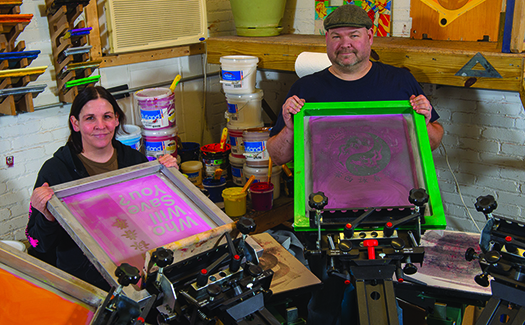A Tale of Two Screen Printers
Communication and community engagement have been crucial to the success of the apparel screen-printing and embroidery company VilleSide Customs.
FULL STORY
It seems fitting that Hi Voltage Productions, Mike Ritchey’s aptly named apparel-decorating business, occupies a former 5,000-square-foot electric power station. Everything about the shop exudes energy, from the colorful rock-and-roll artwork and memorabilia adorning the walls, to a restored pinball machine from the 1960s.
“I started out as a motorcycle messenger, and that exposed me to the colorful, fun side of life,” Ritchey says of his days as a courier in San Francisco. “There was a lot of tattoo, bicycle and hot-rod culture, and everyone wanted T-shirts. The only printing shops around were big shops that didn’t want to deal with a dozen of this or two dozen of that.”
Ritchey began dabbling in T-shirt printing, reading books on the topic and honing his craft with hand-me-down equipment from friends in the business. Initially, printing was “just for fun,” an outlet for his creative talents alongside his love for tinkering (he built his first press out of wooden boards attached to a work table), and building custom choppers and low riders.
But as Ritchey’s customer base began to grow, he knew it was time to take his business to the next level. Disheartened by ever-increasing rental rates, he and his wife, Tracy, left their small shop in San Francisco and moved to their current warehouse in Harrisburg, Pa., to start Hi Voltage Productions.
PRESSING CONCERNS
While Ritchey retained many of his West Coast clients, his business began to expand nationally. “Our customers are everybody,” he says. “Rock-and-roll bands, theater groups, car clubs, bars. Everyone wants T-shirts.”
In addition to running an automatic press he purchased from a friend, Ritchey used a six-color/four-station manual press from his old shop. Business was booming, but his outdated printing equipment couldn’t keep up with demand and began to falter.
“I used to do four dozen pieces, and suddenly we had requests for 1,200 of this and 1,500 of that,” he says. “I was running older presses that weren’t well calibrated, or expandable in any way. We’d be here until [3 a.m.], one print would come out perfect and [suddenly] the registration would wander off, and the next print would be off an eighth of an inch.”
Ritchey soon purchased a Vastex six-color/six-station V2000HD manual press and later upgraded to an eight-color/eight-station model within a year. Two more arms and pallets increased the shop’s output and allowed him to run multiple jobs simultaneously. The configuration also worked well with his two other screen-printing presses.
“With three presses, we are bouncing around from one to another,” he says. “It really helps production because I don’t have to wait for a press to be available to put the next job on.”
Taking the plunge and investing in new equipment also meant Ritchey could significantly reduce registration time, resulting in more accurate results and higher volume.
“I can register a simulated process [job] in eight minutes, which would take me an hour on the other presses, and the registration would wander,” he says. “We do a lot of art prints for bands, and they want crazy graphics. If we didn’t have perfect registration they would look terrible.”
TURNING UP THE HEAT
With upgraded presses, Ritchey soon realized the shop needed a better dryer, as its 40-year-old model couldn’t accommodate production rates. He bought one with a 30-inch-wide belt and digital temperature control.
“My last dryer didn’t have digital technology, so the temperature would be [unreliable],” he says. “We were either undercuring shirts or burning them.” With the new dryer, Ritchey cures 150-200 T-shirts an hour — and has cured as many as 350 in that timeframe.
With the upswing in production, Ritchey still needed to turn up the heat, so he bought a second dryer with a 30-inch belt that cures up to 130 pieces an hour. “With just one dryer, we could only run two presses at one time, and there were plenty of times I’d have to go to my office and wait for the dryer to become available,” he says.
The second dryer paid for itself in less than two weeks and has increased Hi Voltage Productions’ productivity by 30%.
“With two dryers I can run all three presses at the same time,” he says. “That’s where the profits lie.”
Ritchey doesn’t plan to stop there. He hopes to replace the shop’s old six-color/four-station manual press with a newer six-color/six-station model in the near future, estimating it will increase production another 15%-20%.
Ritchey says the future investment should preserve Hi Voltage Productions’ profitability. “Any printer will tell you when your presses are spinning you’re making money.”
Mark Vasilantone is owner of Vastex Intl. Inc. and builds on the legacy of his father, Michael Vasilantone, the company’s founder, an inventor and pioneer in mass producing screen-printed T-shirts. For more information or to comment on this article, email Mark at mark@vastex.com.
Hi Voltage Productions at a Glance:
Company Name: Hi Voltage Productions
Address: 628 Maclay St. Harrisburg, PA 17110
Decorating Methods Offered: Screen printing, art services
Company Website: hivoltagepa.com
Communication and community engagement have been crucial to the success of the apparel screen-printing and embroidery company VilleSide Customs.
FULL STORYStrap yourselves in because we are back on the road to complete our live-decorating adventure! This time visiting Equipment Zone and STAHLS’.
FULL STORYBuckle up ‘cause we are on a mission! In the ever-evolving world of technology, there are so many ways to tap into your creative outlet and turn it into a lucrative business in the decorated-apparel industry.
FULL STORY